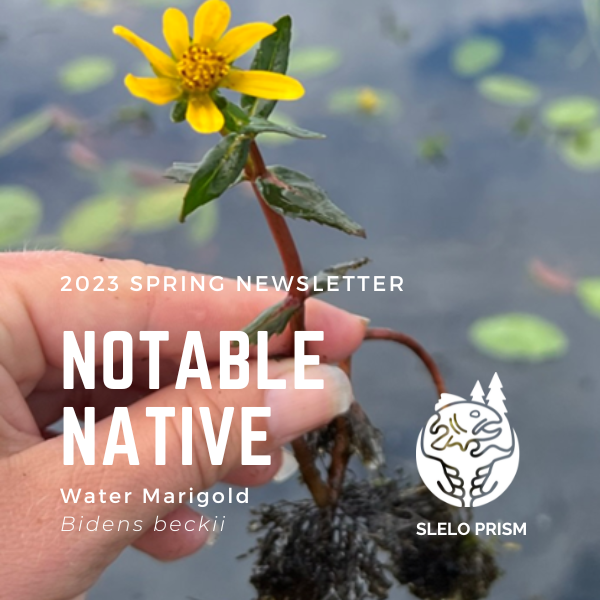This article was featured in the 2023 Spring Newsletter by Brittney Rogers-SLELO PRISM.
Water Marigold, Bidens beckii, is commonly found in shallow slow moving waters, considered to be a more uncommon species in the northeast. Through our early detection surveys, team SLELO has only encountered Bidens beckii, in St. Lawrence and Jefferson counties while NYFA indicates there are records in all 5 counties of our region. B. beckii is considered an indicator species as it is often one of the first submersed plant species to die when water quality declines. It is very valuable to the ecosystem as the foliage of B. beckii provides shade, shelter and foraging opportunities for fish, the flowers are pollinated by insects, and the fruit serves as a food source for waterfowl.
beckii has two distinct leaf types, the submersed and aerial leaves which differ greatly. Submersed leaves are finely divided and oppositely arranged along the stem, with each leaf dividing three times right at the stem- creating a whorled appearance.
If you’re lucky enough to see this species flower, the stem emerges from the water with lance-shaped serrated leaves also oppositely arranged. Blooms are yellow and appear daisy-like.

Native lookalikes for B. beckii include coontail and the water crowfoot species in the Ranunculus family. Due to its similar submersed leaves, B. beckii is commonly misidentified as the invasive aquatic plant called fanwort, Cabomba caroliniana. The presence of a distinctive petiole is the easiest way to distinguish fanwort from the native water marigold along with other distinguishing characteristics listed below sourced from the Wisconsin Aquatic Invasive Species Early Detector Handbook.
Fanwort is present in Kosoag Lake in Williamstown and has been managed for multiple years and is significantly suppressed. A fanwort survey was conducted in 2016 in the west branch of Fish Creek that connects Kosoag Lake to Oneida Lake, no fanwort was found in the Creek but it hasn’t been surveyed in 7 years. Volunteers are wanted to help survey this section of Fish Creek, and suggested survey sites can be viewed on our story-map under the Fanwort Tab.



